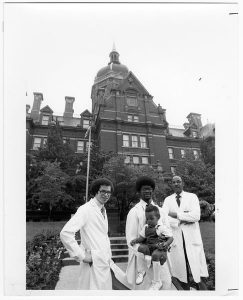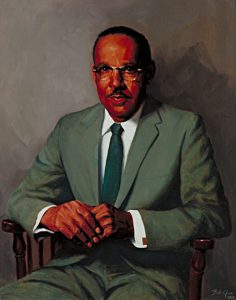~This post courtesy of Phoebe Evans Letocha, Collections Management Archivist, Alan Mason Chesney Medical Archives Johns Hopkins Medical Institutions.
To commemorate February as both Black History Month and American Heart Month, the Medical Heritage Library salutes the contributions of Vivien Thomas, an African American surgical technician at Johns Hopkins.
Born in Lake Providence, Louisiana on August 29, 1910, Vivien Thomas grew up attending segregated public schools in Nashville Tennessee. In 1930 after being forced to drop out of pre-medical studies in college when his life savings were wiped out by a bank crash, Thomas took a position as a laboratory assistant to surgeon Alfred Blalock at Vanderbilt University. Thomas’ abilities as a surgical assistant and research associate were of the highest quality, and when Blalock moved to Johns Hopkins in 1941 he asked Thomas to accompany him to Baltimore.
At Johns Hopkins, Thomas collaborated with Alfred Blalock and Helen Taussig to devise the operative technique to correct a congenital heart defect, Tetralogy of Fallot, or “Blue Baby Syndrome” that robs the blood of oxygen. First performed in 1944, the anastomosis operation named the Blalock-Taussig Shunt, brought fame to Blalock and Taussig. However due to racial prejudice at the time and the academic custom of not giving credit to non-degreed lab assistants, Thomas’s contributions went unrecognized. He was a hidden figure, critical to the success of the operation. He worked out the surgical technique in the dog lab, using a clamp of his own design, and coached Blalock in the operating room through the first human operation.

Third year medical student Reginald Davis holding a child with Levi Watkins, and Vivien Thomas in front of Johns Hopkins Hospital Administration Building, 1979
Thomas’ achievements were finally recognized formally by Johns Hopkins with a portrait presented in 1971, and with a 1976 faculty appointment and honorary degree from the University. He retired in 1979 to write his autobiography, Pioneering Research in Surgical Shock and Cardiovascular Surgery: Vivien Thomas and His Work with Alfred Blalock (Philadelphia: University of Pennsylvania Press, 1985), later republished as Partners of the Heart: Vivien Thomas and his work with Alfred Blalock (1998). Sadly, Thomas died November 26, 1985, just as the book was published. In 2005, the Johns Hopkins University School of Medicine named one of its 4 new colleges after Vivien Thomas.
Thomas’ story was dramatized in the 2004 HBO film Something the Lord Made, and the 2003 PBS documentary Partners of the Heart.
MHL partner, the Alan Mason Chesney Medical Archives of the Johns Hopkins Medical Institutions houses the Vivien Thomas Collection, and in 2015 published a finding aid to the processed collection. The collection includes the manuscript and its various drafts for the memoir, along with correspondence principally with Mark Ravitch, one of the surgeons Thomas had trained at Hopkins and who assisted Thomas in editing the book and securing a publisher.






